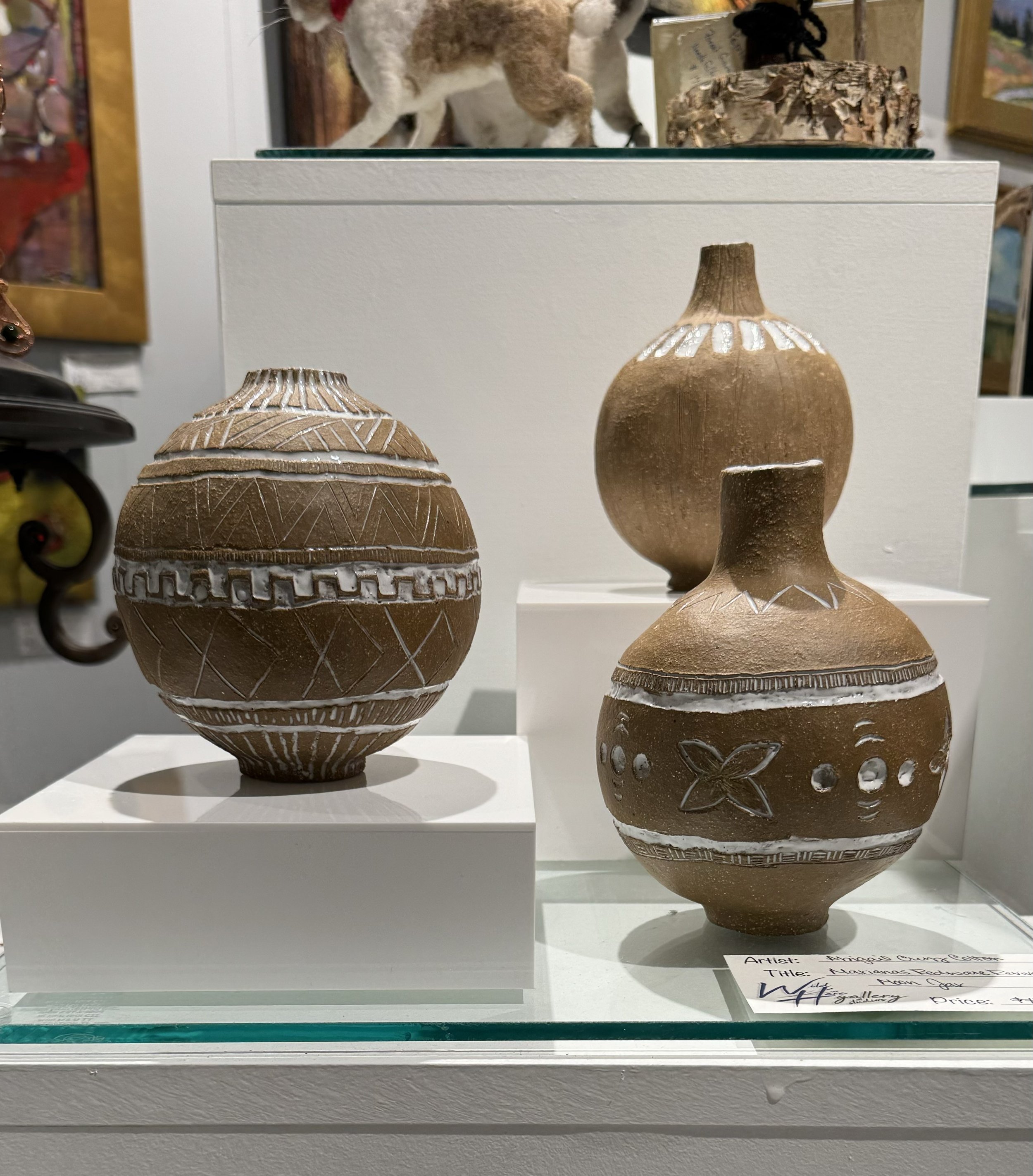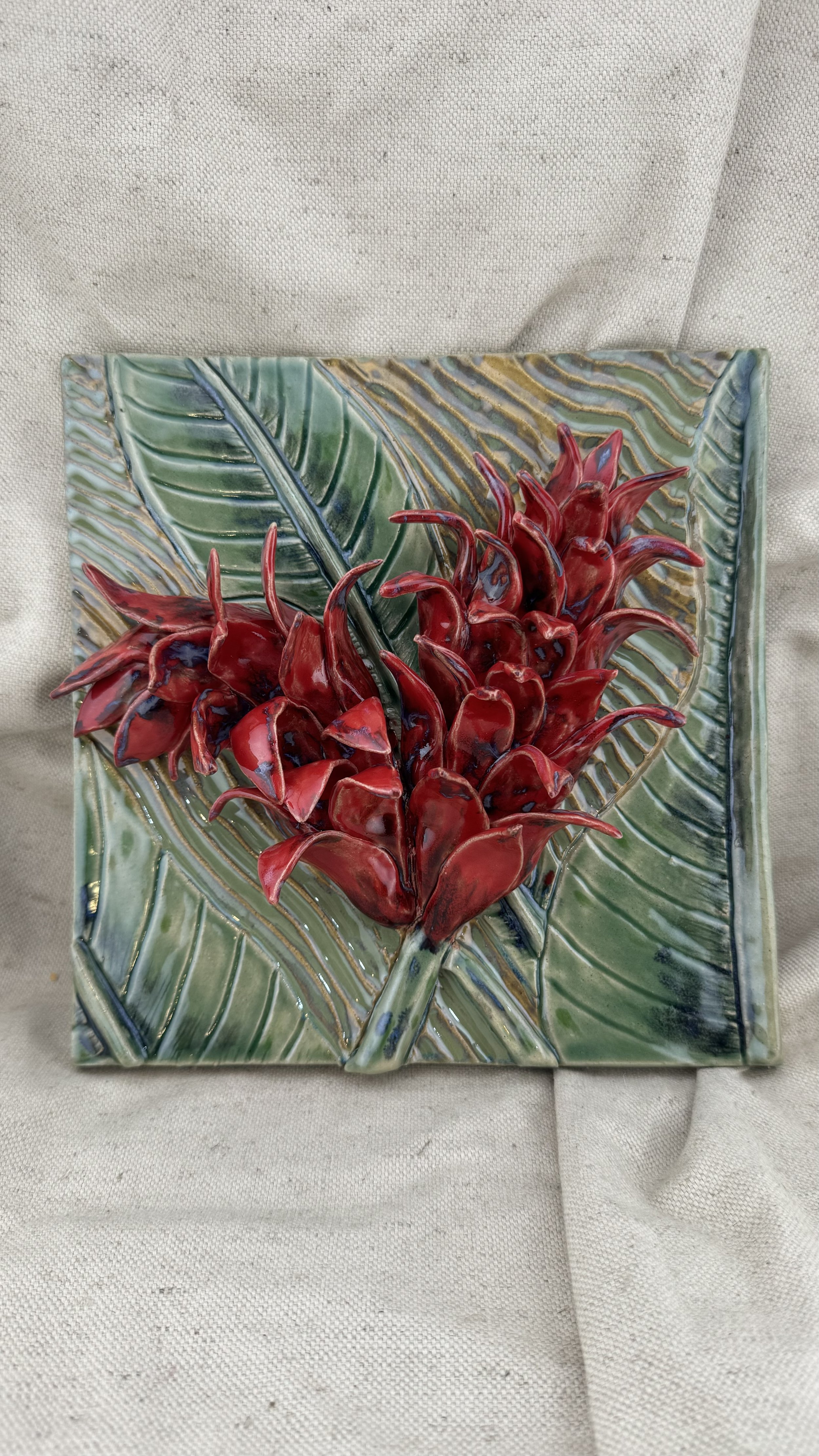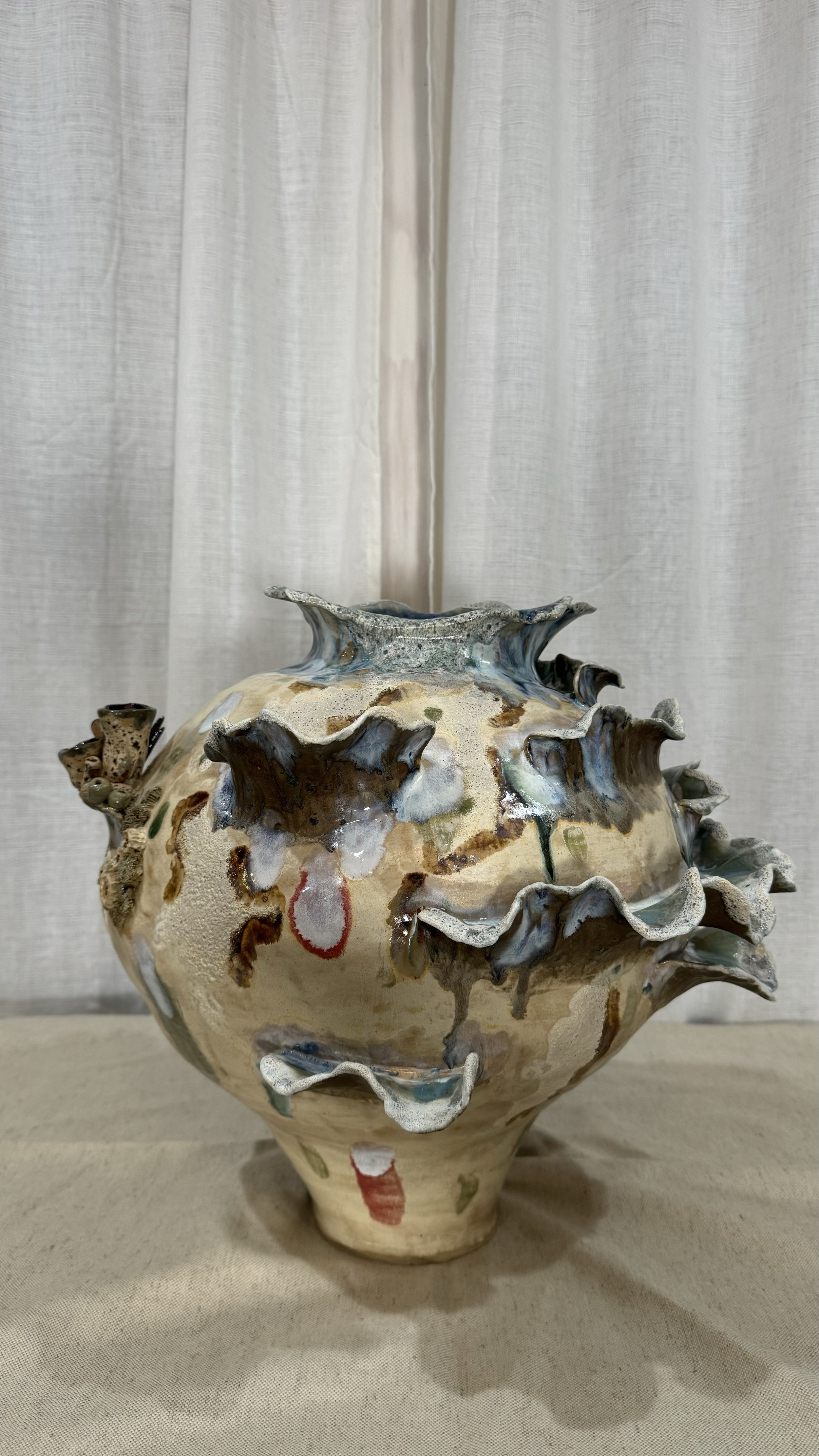046: Abigail Cruz Colton
Based in South Carolina, Abigail Cruz Colton is a CHamoru ceramic artist and the proud owner of Pårådisu Pottery.
Abigail Cruz Colton
Cruz Colton crafts handbuilt ceramics that reflect the organic shapes and textures of her surroundings. Her work is deeply personal, blending the beauty of nature with the memories of her island upbringing. Alongside her studio work, she is passionate about making art accessible to all, teaching pottery classes throughout her local community.
Cruz Colton defines art as the creative expression of human experience, encompassing life's emotions, events, and even the mundane. She finds a unique connection to ceramics, a material derived from the earth itself, which links her to generations of ancestors who also practiced this ancient craft. This connection to both the earth and her CHamoru heritage drives her artistic exploration, particularly as she seeks to learn more about traditional pottery techniques.
Abigail Cruz Colton
Nature is at the heart of Cruz Colton’s work, with the landscapes of the Blue Ridge Mountains and her childhood memories of Guam serving as constant sources of inspiration. She admires artists like Freya Bramble Carter, whose spontaneous and soulful approach to pottery aligns with her own desire to break the rules and create freely. When facing creative blocks, Cruz Colton steps away from her work, often finding clarity in outdoor activities or allowing herself the space to simply reset and let inspiration return naturally.
Texture is a significant element in her ceramics. She enjoys exploring the tactile qualities of clay, from rough carvings to smooth, burnished surfaces, always aiming to incorporate unique textures into her pieces. Her process is primarily slab-built, with her current focus on tiles. Each piece she creates bears a Bird of Paradise stamp, her unique signature. However, balancing her drive to complete projects with the temptation to start new ones remains a challenge.
Abigail Cruz Colton
For Cruz Colton, artists are storytellers who interpret and communicate emotions, events, and histories through their work. Over time, she has observed her own artistic voice becoming more distinct. Since fully committing to ceramics in 2023, her work has evolved, reflecting a greater sense of self. To aspiring artists, she advises staying true to their creative visions, continually making time to create, and not letting trends or pressures interfere with their artistic growth.
“Never let the pressures or trends of today hinder you from being your truest or most artistic self.”
To read Abigail Cruz Colton’s full interview, continue reading below. Also, check out her work on Instagram (@paradisu.pottery) and support her journey by taking her classes and purchasing her amazing pottery on her website. Thank you for your time!
Abigail Cruz Colton
Please introduce yourself and describe what you do.
Hafa adai! My name is Abigail Cruz Colton. I am a CHamoru ceramic artist and the proud owner of Pårådisu Pottery, living in the upstate of South Carolina. My work is influenced by the unmatched beauty of the stunning landscapes of the Blue Ridge Mountains, where I currently live, as well as the fond memories that I hold from my childhood spent on Guam. The textures, colors, and forms found in these picturesque settings serve as endless sources of inspiration for my creations. Most of my works are handbuilt, and I rely heavily on organic shapes and the natural look of clay. In addition to creating, I've also discovered a love for teaching. I firmly believe that art and creative exploration should be available to everyone, so when I'm not in the studio, you can find me around the upstate teaching a class and sharing the wonder of this beautiful medium.
How would you define art?
This question could be written about for pages and pages, and the conglomeration of those words still wouldn't scratch the surface of what art is! But I think that simply put, art can be defined as the creative expression of the human experience. It is a physical interpretation of all of the joys, sorrows, surprises or even the mundanities of life.
Why did you choose your art form?
I chose ceramics because the idea of using a material directly derived from the ground and having that ability to turn it into something beautiful or useful, or both, brings a deeper level of intimacy to the process. In addition to bringing a feeling of connection to the earth, ceramics is an art form that has been used pretty much since the beginning of mankind and knowing that generation upon generation of our ancestors used these same methods makes me feel more connected to my heritage and gives me the drive to explore their methods of creating ceramic wares.
How does your background (education, culture, etc.) affect the artwork you make today?
I am a CHamoru who now lives on the mainland, but I was 13 when we moved, so I remember, with great detail, what my island home looked like. Because of this, I am able to use many of those memories as inspiration and translate them into my art. I've recently been delving deeper into ancient CHamoru pottery as well. Unfortunately there isn't a wealth of knowledge about this subject that is readily available, so I've studied what I can through the internet and hope to make it to the island sometime soon to explore more.
Who do you idolize?
There is a ceramic artist who was featured on the second season of The Great Pottery Throwdown named Freya Bramble Carter who I became absolutely infatuated with. She draws a lot of the inspiration for her work from nature but also says that she uses her soul to create, rather than her mind and also leans into "unlearning" the rules when she creates. I love her freedom and spontaneity and hope to achieve that in my own work as well.
Where do you get your inspiration?
I am inspired by the nature found in the area I currently live in (foothills of the Blue Ridge Mountains) as well as the memories I have from my childhood spent on Guam.
What do you do when you're stuck on an artwork or lacking motivation or inspiration?
When I'm stuck or lacking inspiration for new pieces, I put everything down and do something else. Sometimes that involves spending time outside, going for a bike ride or a run on the trail that goes through my town or I work on something else that doesn't require much creative thought. Sometimes I just sit and allow myself to be stuck because I know it'll pass soon. Thankfully, I am in an area that is teeming with resources for inspiration, so even if I find myself in a creative gridlock, it does not last long.
What do you like incorporating most into your art?
My favorite thing to incorporate into my art is texture. I am a bit obsessed with the many tactile qualities of clay and how easy it is to achieve endless textures and feelings. I love rough carvings or squiggly lines, but I also love a burnished, completely smooth surface. The ability to achieve all of these never fails to blow my mind, so I always try to include a little bit of funky texture where I can.
What is something that you add to your art as your signature?
My artistic style is versatile, so I don't have a singular item that is made onto each piece, but I do have a little bird of paradise stamp that I add to all of my pieces.
Take us through your process for making art.
Most of my art is slab built, which includes rolling large, flat sheets of clay and using them to make my pieces. I am currently into tiles, so for those, I come up with a design, make a plaster mold of said design, and then press fresh plastic clay into the mold to form a tile. They are dried completely flat and slowly to prevent warping, then fired once to vitrify the clay. Once fired, they are taken out of the kiln, glazed, then fired again to create the finished product.
What do you struggle with the most when making art?
I think I struggle most on sticking with my projects. My mind is constantly moving and wanting to start on the next best thing, so when I have a large project that I'm working on and another idea comes to mind, I really have to focus on finishing what's in front of me instead of starting on that fun cool idea that I just came up with.
What role do artists have in society?
Artists are messengers. Our job is to articulate -- feelings, current events, historical happenings and everything in between. We hear, see and feel everything and make it our goal to translate it in a visual or tangible way.
What characteristics do you think all artists share?
I think that all artists share the ability to tell stories through their work. They absorb, observe and relay messages, motifs and anecdotes. I also think that most artists possess an incredible amount of zeal. We push forward through whatever obstacle comes our way; we continue to create and share -- not worrying if others care to look or not, and we are not afraid to put our entire being into each and every one of our pieces.
What’s your favorite place in Guam?
My favorite place to be is my family's beach in Agat.
How has your artwork evolved over time?
I only jumped fully back into my work at the beginning of 2023, and in just a year's time I've picked up on a significant change. I notice more of a personal voice in my work that I wasn't able to discern before, and that's been a really liberating thing to finally see.
Why did you choose to become an artist?
I always knew that I wanted to dive deeper into the world of ceramics, but I really think that I became an artist out of necessity. Before I started my business, I was a realtor for one of the top teams in our area. I loved that job and it was so gratifying to guide others throughout the home buying process, but I then realized that I had some pretty serious health problems before my wedding in 2021. I decided to step back from real estate and that's when I realized that I wanted to get back into the clay. I took some refresher classes to get the basics down again, and from there things just took off. I've not looked back since, and I'm healthier and happier than I've ever been. To sum it up, I guess you could say that I became an artist because I was given a new lease on life and clay is the vessel I chose to communicate about it.
Is your art geared towards a specific audience?
No, my art is intended to be enjoyed by anyone and everyone, and I hope to achieve that.
Do you have any tips for aspiring artists?
Always keep creating. Allow yourself the pleasure of making something with your hands. Never let the pressures or trends of today hinder you from being your truest or most artistic self, and always make time to appreciate art. If art is what you want to do, then do it.





